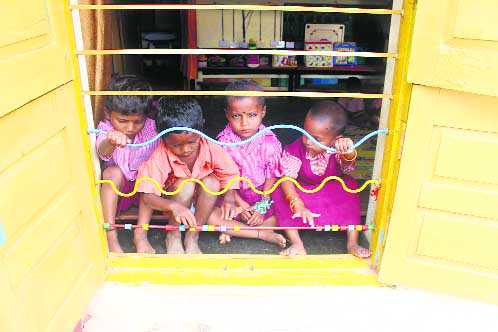AT the moss-kissed Adarsh Anganwadi Centre at Sargipalpara in Kondagaon (southern Chhattisgarh), a fleet of little bare feet, at express pace, makes way through the entrance. Yellow, green and red tiles — distinct amid cemented ones — welcome them. These are meant to help in colour recognition and counting.
What follows is a tile board of stapu (hopscotch) — a fond memory for many an adult of a game that challenges to make quick, mental calculations before the great throw. Next, a pipe play phone forms the railing along the alley to the classroom. It’s no ordinary centre.
Built on the Building As Learning Aid (BALA) concept, it is part of a pilot project for qualitative learning based on infrastructure. The pictorial, activity-based infrastructure is aimed at the holistic growth of a child — “khel khel mein maansik vikas,” as centre supervisor Rajni Dubey puts it.
So, there are elements like bangle-embedded tiles to help in paper tracing, a hand movement design board to develop cursive writing skills, pictorial stories on walls and even an open theatre or manch!
Funded by the United Nations Children’s Fund (UNICEF), it is one of the three such centres in the state whose Human Development Index is among the lowest.
It’s supposed to be an inspiring story, but the reality trickles in through a water slab, made thoughtfully for children of different heights. The unused taps are broken.
The UN arm took over the project in this old building two years ago but once the ball was back in the government’s court, things haven’t been hunky-dory. There is no water in the taps. There is a power connection, but no electricity. UNICEF says it funded the infrastructure as a model for the government to take over and replicate. Chhattisgarh cites budget problems. Out of the 47,000 anganwadis in the state, only 10 per cent have electricity.
So, do such innovative projects stand no chance? A flicker of hope comes from Saguja district in Chhattisgarh. Courtesy the district collector, there is a plan to replicate the model in 25 centres. It is worth a try in every nook and corner of the country.
In Chandigarh, the BALA concept was tried out in government schools, but a Child Development Project Officer says there is no such facility in the anganwadi centres as most operate from rented spaces. The Mayor recently flagged the issue of poor conditions in these centres.
Concrete learning would be a nice way to describe the concept. It calls for innovative methods, local inputs. And the will to do it. What will it take to build that up?
thakurshreyasi@gmail.com
Unlock Exclusive Insights with The Tribune Premium
Take your experience further with Premium access.
Thought-provoking Opinions, Expert Analysis, In-depth Insights and other Member Only Benefits
Already a Member? Sign In Now










